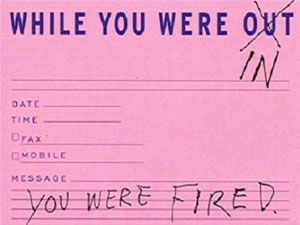OPINION
Without a union, employers can frame and fire at will
By MARK MOSHAY
(Aug. 12, 2014) — We’ve all heard the plea from a convicted criminal, “I was framed!”
Although many guilty persons make that claim, it’s probably safe to say that many times it’s just an attempt to avoid the penalty for their misdeeds. But there are also numerous examples throughout history of individuals who have been framed or set up by their adversaries.
 In the workplace, that happens, too. When a manager seeks to get rid of an employee, framing can be an effective tool. It provides the manager with the means of building a case to fire an employee, even if the evidence is weak and inconclusive.
In the workplace, that happens, too. When a manager seeks to get rid of an employee, framing can be an effective tool. It provides the manager with the means of building a case to fire an employee, even if the evidence is weak and inconclusive.
The art of framing by management takes some skill, but once you have the basics down, it’s a template that can be used to make a decent employee look like the scum of the earth.
Here are some examples.
A manager accuses an employee of being unstable. The goal then is to take any situation that can be exploited to make the employee fit that hypothesis. So the manager gathers every tidbit of information to make the employee look bad:
| What actually happened
|
How it is framed
|
| One day John was in the lunch room banging on the vending machine because the snack he purchased was hung up on the wire coil. John was also frustrated and used a few choice words about the machine.
|
John had a severe emotional outburst in the lunch room in which he violently slammed a company owned vending machine. He used expletives and created an unsafe environment for other employees.
|
| John was asked if he’d attended the staff meeting the previous week. But he forgot that he was actually off that day and misspoke. The month prior, his manager had asked about report that he was certain he had already submitted. Upon checking his files he realized he hadn’t and promptly turned it in.
|
John was asked about his attendance at last week’s staff meeting and lied saying that he was present at the meeting. Last month he was also asked about a report that he had turned in and he lied saying that he had submitted it, when he had not done so. This pattern of dishonesty is of great concern to management.
|
| John got into a disagreement with another employee. Words were exchanged. John later apologized to the other employee. | John has behavioral issues and is causing other employees to feel unsafe around him. |
These are actual examples that managers have used to frame an employee. The principle is very simple. Take even the slightest imperfection and highlight it in the most unflattering way. Then make the effort to “connect the dots” to show a “pattern of behavior,” even if such behavior isn’t actually occurring.
By doing so, the manager builds a fairly good case for disciplinary action. After all, John has proved to be a bad employee in his attendance, unstable and unsafe in his interaction with other employees, and more seriously, he is a liar and can’t be trusted.
The manager can now take a bold step:
The actions by John taken independently are of concern and should be dealt with by corrective action. However, all of these documented examples of misconduct together warrant immediate discharge. The employer has the right to ensure the safety of their employees, the integrity of the institution, and the adherence to its policies. Clearly, John has failed in all these areas. Therefore, I recommend that John be discharged immediately.
Do you think this is “over the top?” Well, it happens all the time. It’s happened to me personally and to many employees I have represented in my 25 years as a union representative.
Here’s the good news, there is a principle in labor law called “the standards of just cause.” It means that employers have to meet a number of criteria to show that the disciplinary action they have taken is appropriate. So, for example, an employer who fires someone for taking home a pen, would probably be found in violation of just cause.
Sadly, for unrepresented workers, there is no such protection. It amazes me that the vast majority of American workers fail to see how vulnerable they are without the protection of a union contract. Even with that protection, it can be quite a battle to take on an employer bent on firing an employee, but an unrepresented worker? There is nothing, not one shred of protection for them.
You often hear about individuals filing a lawsuit against an employer after being fired. But let’s look at reality. Filing a lawsuit requires two important elements, time and money (lots of money). Few workers have either. When you lose your job, your whole life is turned upside-down. The idea of finding a lawyer and waiting for everything to play out over a long period of time, often years, is simply a non-starter.
Framing is a clever tool used by those who want to sell an idea. To some degree we all use that tactic. After all, if I’m going to encourage someone to join a union, I’m not going to list all the bad examples of one right up front.
However, there is a breakpoint in my mind. You have to decide if you are going to be honest and demonstrate integrity, or if you are going to operate on the basis of the “end justifies the means.”
I have met a number of managers who refused to compromise their principles. These are individuals who play by the rules, they are fair, even if they take a position I disagree with, I know they will behave honestly in the process.
But when I encounter a manager who is hell bent on firing an employee, I always look for tell-tale signs of framing. When I find them, I identify them and make my best effort to expose each instance. However, doing so takes a lot of effort and it can be a huge challenge.
 That said, workers who’ve been framed and lack union representation are in a much worse state — a state of hopelessness.
That said, workers who’ve been framed and lack union representation are in a much worse state — a state of hopelessness.
Mark Moshay has been a labor representative for the past 25 years. Since 2000, he has been Contract Administrator for the Society of Professional Engineering Employees in Aerospace (SPEEA), IFPTE Local 2001. Prior to joining SPEEA, he served for eight years as President of IFPTE Local 6 in Bremerton. He can be contacted at markm@speea.org.





